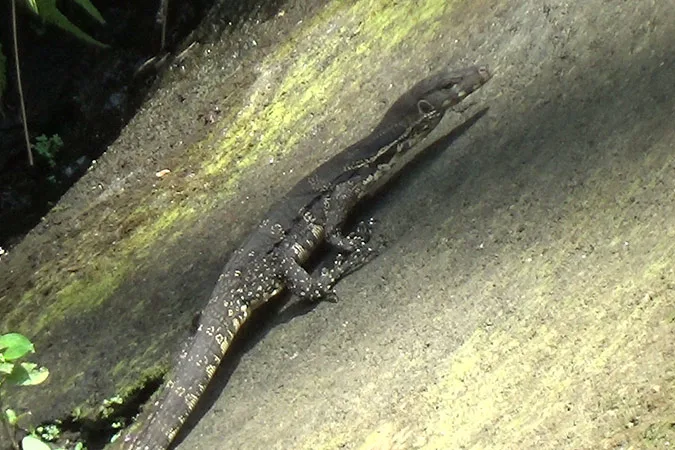Biawak or common water monitor (Varanus salvator) is a species of animal in Varanidae, large lizards that live near freshwater and mangrove forests, semi-aquatic, good swimmers with paddle tails, strong jaws, sharp hoofed legs, adapt and thrive in local areas farms and cities with canal systems for elevations below 1000 meters.
V. salvator has a length of 1.5-2 meters and weighs up to 20 kg as the second heaviest lizard in the world after the Komodo dragon. A muscular body with a long, strong and paddle tail. The scales on the keel and on the head are larger than those on the back.
Commonly brown or blackish in color with a yellow spot on the underside and tends to disappear gradually with age. The band extends from each eye and back over each edge of the back, upper tail and upper legs.
Very long neck, elongated muzzle, powerful jaw, serrated teeth and fingertips ending with sharp claws that can be used to climb trees. Long tail, shaped like a paddle, black with yellow rings and pointed tip.
Common water monitors have a semi-aquatic lifestyle inhabiting various natural habitats in primary forests and mangrove swamps. Adapt and develop in vegetated rivers in agricultural areas and cities with canal systems.
Biawak defends itself using its tail, claws and jaws. Carnivores that eat a wide variety of prey including fish, frogs, rodents, birds, crabs, snakes, turtles, young crocodiles and crocodile eggs. They eat by tearing open chunks of meat with sharp teeth while holding them with their forelegs.
Kingdom: Animalia
Phylum: Chordata
Subphylum: Vertebrata
Class: Reptilia
Order: Squamata
Suborder: Sauria
Family: Varanidae
Genus: Varanus
Species: Varanus salvator
Subspecies: Varanus salvator ssp. andamanensis, Varanus salvator ssp. bivittatus, Varanus salvator ssp. macromaculatus, Varanus salvator ssp. salvator, Varanus salvator ssp. ziegleri
V. salvator has a length of 1.5-2 meters and weighs up to 20 kg as the second heaviest lizard in the world after the Komodo dragon. A muscular body with a long, strong and paddle tail. The scales on the keel and on the head are larger than those on the back.
Commonly brown or blackish in color with a yellow spot on the underside and tends to disappear gradually with age. The band extends from each eye and back over each edge of the back, upper tail and upper legs.
Very long neck, elongated muzzle, powerful jaw, serrated teeth and fingertips ending with sharp claws that can be used to climb trees. Long tail, shaped like a paddle, black with yellow rings and pointed tip.
Common water monitors have a semi-aquatic lifestyle inhabiting various natural habitats in primary forests and mangrove swamps. Adapt and develop in vegetated rivers in agricultural areas and cities with canal systems.
Biawak defends itself using its tail, claws and jaws. Carnivores that eat a wide variety of prey including fish, frogs, rodents, birds, crabs, snakes, turtles, young crocodiles and crocodile eggs. They eat by tearing open chunks of meat with sharp teeth while holding them with their forelegs.
Kingdom: Animalia
Phylum: Chordata
Subphylum: Vertebrata
Class: Reptilia
Order: Squamata
Suborder: Sauria
Family: Varanidae
Genus: Varanus
Species: Varanus salvator
Subspecies: Varanus salvator ssp. andamanensis, Varanus salvator ssp. bivittatus, Varanus salvator ssp. macromaculatus, Varanus salvator ssp. salvator, Varanus salvator ssp. ziegleri
